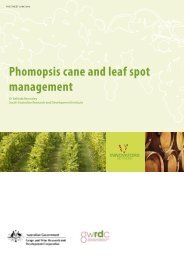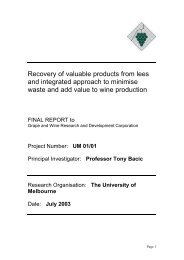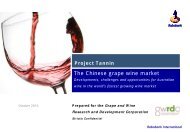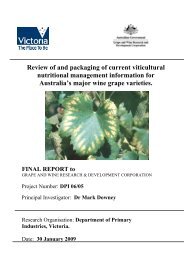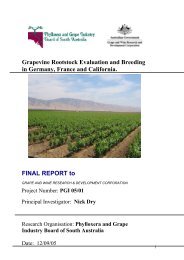Identification of the major drivers of 'phenolic' taste in ... - GWRDC
Identification of the major drivers of 'phenolic' taste in ... - GWRDC
Identification of the major drivers of 'phenolic' taste in ... - GWRDC
You also want an ePaper? Increase the reach of your titles
YUMPU automatically turns print PDFs into web optimized ePapers that Google loves.
AWRI: <strong>Identification</strong> Of The Major Drivers Of ‘Phenolic’ Taste In White W<strong>in</strong>es<br />
<strong>Identification</strong> <strong>of</strong> Chromatography Peaks<br />
<strong>Identification</strong> was carried out <strong>in</strong>itially by analys<strong>in</strong>g commercially-produced HPLC-grade reference<br />
compounds by HPLC-DAD. Table A-2 lists obta<strong>in</strong>ed retention times (RT), UV detector response<br />
factors and spectral characteristics (max listed first) <strong>in</strong> <strong>the</strong> order <strong>the</strong>y elute. A composite sample <strong>of</strong><br />
Chardonnay, Riesl<strong>in</strong>g and Viognier w<strong>in</strong>e made from whole bunch press<strong>in</strong>gs, hard press<strong>in</strong>gs and juice<br />
macerated for 60 hours was concentrated (w<strong>in</strong>e freeze dried and reconstituted <strong>in</strong> 2% formic acid to<br />
yield a 10x concentration factor) was also analysed at <strong>the</strong> same time and this chromatogram and<br />
Figure A-4 : Reference compound HPLC-DAD chromatograms (graphically normalised) overlayed<br />
on a chromatogram <strong>of</strong> a mastermix <strong>of</strong> CHA, RIE, VIO whole bunch-pressed and high phenolic w<strong>in</strong>es<br />
represents this chromatogram positioned under <strong>the</strong> peaks for <strong>the</strong> reference compounds. Compar<strong>in</strong>g <strong>the</strong><br />
RT <strong>of</strong> peaks <strong>in</strong> an unknown w<strong>in</strong>e samples with this database <strong>of</strong> RTs and spectral characteristics it is<br />
possible to tentatively identify compounds <strong>in</strong> <strong>the</strong> unknown. However, <strong>the</strong>re are potentially 100<br />
phenolic compounds <strong>in</strong> white w<strong>in</strong>e and <strong>the</strong> reference compounds cannot reflect all <strong>of</strong> <strong>the</strong>se potential<br />
components.<br />
The only way to identify <strong>the</strong> larger <strong>major</strong>ity <strong>of</strong> <strong>the</strong>se compounds is to use an accurate mass detection<br />
system <strong>in</strong>stead <strong>of</strong> <strong>the</strong> diode array UV detector. The technique <strong>of</strong> HPLC-ESI-QTOF-MS/MS<br />
(Electrospray ionization quadrupole time-<strong>of</strong>-flight mass spectrometry) allows <strong>the</strong> effluent <strong>of</strong> <strong>the</strong><br />
chromatographic column to be sprayed <strong>in</strong>to a mass spectrometer where <strong>the</strong> mass <strong>of</strong> elut<strong>in</strong>g<br />
compounds is determ<strong>in</strong>ed with an accuracy <strong>of</strong> four decimal places. By compar<strong>in</strong>g <strong>the</strong> mass <strong>of</strong> <strong>the</strong><br />
<strong>major</strong>ity ion <strong>of</strong> each compound and <strong>the</strong> breakdown products aga<strong>in</strong>st all possible comb<strong>in</strong>ations <strong>of</strong><br />
carbon, hydrogen, oxygen and sulfur it is possible to identify chromatographic peaks and most<br />
importantly for those which no commercial reference compounds are available. The difference<br />
between <strong>the</strong> measured mass and <strong>the</strong> <strong>the</strong>oretical mass <strong>of</strong> a tentatively identified compounds is , given<br />
<strong>in</strong> mDa; this must be < 3 for a reliable fit <strong>of</strong> structure. All <strong>of</strong> <strong>the</strong> hydroxyc<strong>in</strong>namic acids have<br />
potentially two positional isomers (trans or cis) which cannot be assigned by mass spectrometry, only<br />
by runn<strong>in</strong>g reference compounds or us<strong>in</strong>g NMR can <strong>the</strong>se configurations be assigned and <strong>in</strong> <strong>the</strong> case<br />
<strong>of</strong> <strong>the</strong> tartaric esters and GRP conjugates <strong>the</strong>se are not commerically available and <strong>the</strong>refore requir<strong>in</strong>g<br />
lengthy and complicated syn<strong>the</strong>sis. The same sample composite sample and reference compounds<br />
were analysed under <strong>the</strong> same chromatographic conditions as above. Trifluroacetic acid (TFA) was<br />
not <strong>in</strong>cluded <strong>in</strong> <strong>the</strong> mobile phase to m<strong>in</strong>imise ionisation suppression. This only had a marg<strong>in</strong>al effect<br />
on peak shape for a small number <strong>of</strong> compounds. Major peaks were identified by compar<strong>in</strong>g <strong>the</strong> exact<br />
mass <strong>of</strong> extracted molecular features aga<strong>in</strong>st <strong>the</strong> MassBank database. With <strong>the</strong>se new compounds<br />
identified, <strong>the</strong> UV spectra <strong>of</strong> <strong>the</strong> hi<strong>the</strong>rto unknown peaks were added to <strong>the</strong> UV library potentially<br />
allow<strong>in</strong>g better identification when us<strong>in</strong>g only <strong>the</strong> HPLC-DAD technique.<br />
A.3.4 Conclusion<br />
This new analytical method us<strong>in</strong>g two <strong>in</strong>l<strong>in</strong>e Gem<strong>in</strong>i C6-phenyl HPLC columns now makes it<br />
possible to analyse greater than 80 identified phenolic components. This degree <strong>of</strong> separation has been<br />
achieved with only very m<strong>in</strong>imal sample handl<strong>in</strong>g (removal <strong>of</strong> alcohol). Such degree <strong>of</strong> separation has<br />
only been achieved to date with extensive time-consum<strong>in</strong>g extraction/isolation (Baderschneider &<br />
110




